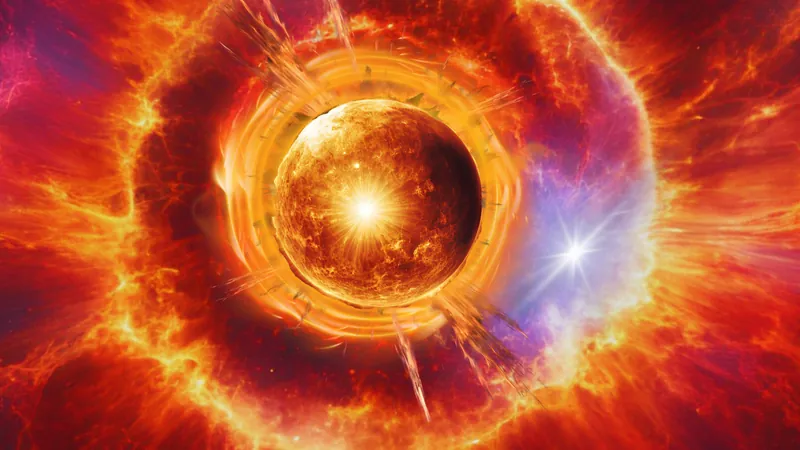
Cosmic Detectives Uncover Secrets of Mysterious Red Novae: A Stellar Revelation!
2025-03-26
Author: Wei Ling
In the world of astronomy, terms like “Intermediate Luminosity Red Transients” (ILRTs) might not ring a bell, but this enigmatic category of stars presents a perplexing puzzle for scientists. A dedicated global team of astronomers, calling themselves the “stellar Sherlocks” in homage to the famed detective Sherlock Holmes, have made significant strides in unraveling the mysteries surrounding these rare celestial beings.
ILRTs are intriguing because they shine with varying brightness - not quite as explosive as traditional supernovae, yet more dramatic than typical novas. This balance has left scientists scratching their heads, questioning whether these stars culminate their life cycles with destructive explosions, or if they somehow survive these violent transitions.
The breakthrough came in 2019 with the discovery of three new ILRTs, prompting researchers to commence a deep dive into their characteristics. Giorgio Valerin, a prominent researcher from Italy’s National Institute for Astrophysics (INAF), emphasized the importance of long-term observation: “We have gathered extensive data through a range of telescopes worldwide and even from some in space,” Valerin shared, referring to their studies that included the highly advanced James Webb Space Telescope (JWST) and the Neil Gehrels Swift Observatory.
One particular subject of their scrutiny is NGC 300 OT, the closest ILRT ever recorded, located merely six and a half million light-years away from Earth. By combining ground-based telescope data and deep-space observations, the team monitored the fading glow of NGC 300 OT over more than a decade. Spitzer Space Telescope’s findings indicated that this star dimmed dramatically, decreasing to just a tenth of its original brightness.
This long-term study revealed a pattern of behavior among ILRTs, particularly as observed in another ILRT, AT 2019abn, in the nearby Messier 51 galaxy. Their brightness decline suggests a probable outcome of total destruction, similar to that of NGC 300 OT, causing speculation on why these stars are less brilliant than typical supernovae.
A critical piece of the puzzle lies in the dense shroud of gas and dust enveloping ILRT progenitors. This protective covering heats rapidly during explosive events, reaching staggering temperatures of approximately 10,300 degrees Fahrenheit (5,700 degrees Celsius) within days. The rapid heating leads to the gas escaping at speeds of about 1.6 million miles per hour, akin to the speed of a fighter jet but still significantly slower than the speeds recorded in more violent supernovae explosions.
“This slowdown allows us to postulate that, although the core of the star experienced an explosive death, the surrounding dense materials absorbed much of the energy, resulting in a less luminous outcome,” explained Leonardo Tartaglia, a fellow INAF researcher.
The scientists introduced the concept of "electron capture supernovae," which theorize a new category of stellar endings not previously believed to have been observed. It suggests a crucial division between stars that explode into supernovae yielding neutron stars or black holes and others that fade away into less dramatic white dwarfs.
Valerin's team believes that these findings mark a significant shift in our understanding of stellar evolution. "We are finally witnessing the phenomena that delineate the fate of different stars based on their mass," he stated, illuminating a pathway towards unraveling cosmic secrets that could change our understanding of life and death in the universe.
As astronomers make strides in grasping the complexities of ILRTs, they not only edge closer to solving the mysteries of these cosmic beings but also open doors to a broader understanding of stellar life cycles overall. The investigations continue, and who knows what other astronomical mysteries the “stellar Sherlocks” will unveil next? Stay tuned, as the universe holds many more secrets waiting to be discovered!



 Brasil (PT)
Brasil (PT)
 Canada (EN)
Canada (EN)
 Chile (ES)
Chile (ES)
 Česko (CS)
Česko (CS)
 대한민국 (KO)
대한민국 (KO)
 España (ES)
España (ES)
 France (FR)
France (FR)
 Hong Kong (EN)
Hong Kong (EN)
 Italia (IT)
Italia (IT)
 日本 (JA)
日本 (JA)
 Magyarország (HU)
Magyarország (HU)
 Norge (NO)
Norge (NO)
 Polska (PL)
Polska (PL)
 Schweiz (DE)
Schweiz (DE)
 Singapore (EN)
Singapore (EN)
 Sverige (SV)
Sverige (SV)
 Suomi (FI)
Suomi (FI)
 Türkiye (TR)
Türkiye (TR)
 الإمارات العربية المتحدة (AR)
الإمارات العربية المتحدة (AR)